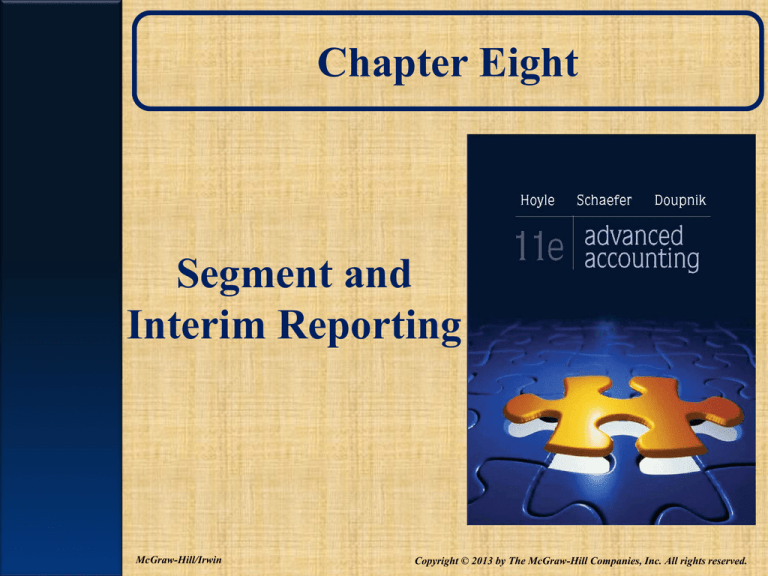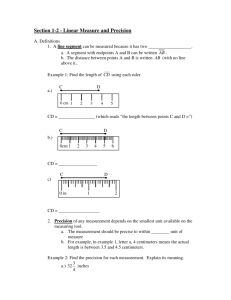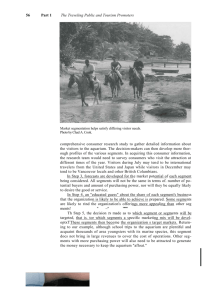
Chapter Eight
Segment and
Interim Reporting
McGraw-Hill/Irwin
Copyright © 2013 by The McGraw-Hill Companies, Inc. All rights reserved.
LO 1
Rationale for
Segment Reporting
Segment reporting provides information to
help users of financial statements to:
Better understand the entity’s
performance.
Better assess the entity’s prospects for
future cash flow.
Make more informed judgments about
the enterprise as a whole.
8-2
Determining Segments
An operating segment is a component of an
enterprise:
That engages in business activities from which
it earns revenues and incurs expenses
Whose operating results are regularly
reviewed by the chief operating decision
maker to assess performance and make
resource allocation decisions
For which discrete financial information is
available
8-3
Determining Segments
Operating segments should be combined
based on the:
nature of the products or services provided
by each operating segment.
nature of the production process.
type or class of customer.
distribution methods.
nature of the regulatory environment.
8-4
LO 2
Quantitative Thresholds
A Segment is considered reportable if it satisfies
one of these tests:
Revenue test
- Its revenues are 10% or more of
the combined revenue of all segments.
Profit
or Loss test - Its profit or loss is 10% or
more of the combined profit (or combined loss if
larger) of all segments reporting a profit.
Asset
test - Its assets are 10% or more of the
combined assets of all operating segments.
8-5
Operating Segment Tests Other Guidelines
The combined sales revenues of the disclosed
segments must be at least 75% of total
company sales, excluding intra-entity sales.
Segments must be added until the 75% test is
met (even if the additional segments do not
meet the reportable segment criteria).
Although a maximum number is not
prescribed, authoritative literature suggests
that 10 separately reported segments might be
the practical limit.
8-6
LO 3
Required Segment Disclosures
For each reportable segment, a company is
required to disclose:
General information
Segment profit or loss
Revenues
Interest revenue and expense
Depreciation, depletion and amortization expense
Significant noncash and unusual items
Income Tax expense
Investment in equity method affiliates
Total assets
Capital expenditures
8-7
8-8
LO 4
Geographic Areas
Revenues from external customers and longlived assets must be disclosed for:
The domestic country.
All foreign countries where the enterprise
derives revenue or holds assets.
Each foreign country in which a material
amount of revenue is derived or assets are
held.
8-8
8-9
LO 5
Major Customers
When 10% or more of a company’s
revenue is derived from a single
customer, the company must disclose
that it has a major customer.
The IDENTITY of the major customer
need not be disclosed.
8-9
LO 6
IFRS and Segment Reporting
IFRS and GAAP are substantially the same,
except…
IFRS requires disclosure of total assets AND
liabilities if that information is provided to
the chief decision maker.
IFRS specifically includes intangible assets
as long-lived assets.
In a company with a matrix form of
organization, IFRS permits operating
segments to be based on geographic area, as
opposed to products/services.
8-10
LO 7
Interim Reporting
To provide more timely information, the
SEC requires quarterly statements from
publicly-traded companies in the U.S.
But how do the statements fairly reflect
expenses that do not occur evenly
throughout the year?
8-11
Interim Reporting
There are two possible approaches:
Discrete – the accounting period
stands on its own.
Integral – treat the accounting
period as a portion of a longer
period.
Current GAAP requires companies to
use the Integral Approach.
8-12
Interim Reporting –
Minimum Disclosures
LO 8
Sales or Gross
Revenues
EPS
Provision for Income
Taxes (and significant
changes in estimates)
Seasonal
Revenues &
Expenses
Unusual or
Extraordinary
Items
Disposal of
a Business
Segment
Contingent
items
Other
significant
changes
Net Income
8-13
LO 9
IFRS -- Interim Reporting
IAS 34 requires the following minimum components
in an interim report:
• A condensed statement of financial position (balance
sheet).
• A condensed statement of comprehensive income,
presented as:
a. A condensed single statement of net income and
comprehensive income, or
b. Separate condensed statements of net income and
comprehensive income.
• A condensed statement of changes in equity.
A condensed statement of cash flows.
Selected explanatory notes.
8-14
IFRS -- Interim Reporting
IAS 34 requires each interim period to be treated as a
discrete period in determining the amounts to be
recognized. Expenses that are incurred in one quarter
are recognized in full in that quarter, even though the
expenditure benefits the entire year.
No accrual of expenses in earlier quarters for
expenses expected to be incurred in a later quarter of
the year. The only exception to this rule is the accrual
of income tax expense at the end of each interim
period.
8-15
Summary
Segment reporting provides more detailed
information about the components of a business
combination for decision makers.
Three quantitative tests used to identify reportable
segments: revenue, profit or loss, and asset.
Companies must report specific information for each
reportable operating segment, and parameters
determine the number of segments it reports.
With interim reporting, GAAP requires an integral
approach, but the IASB’s requires that each interim
period be treated as a discrete period in determining
amounts to be recognized.
8-16








